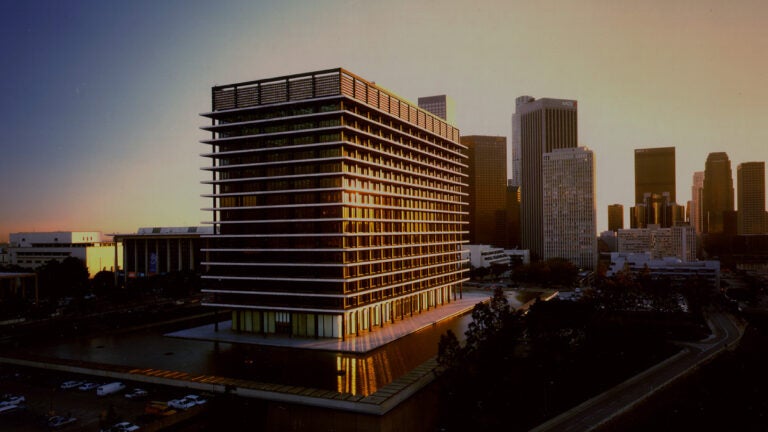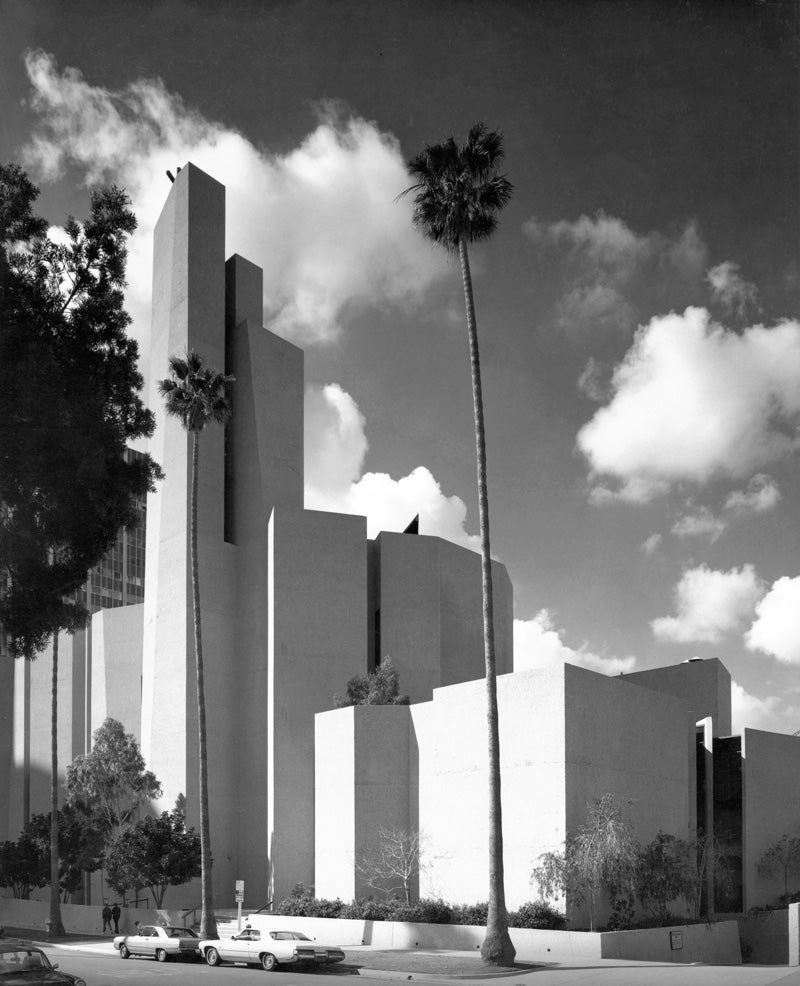
DWP building in Los Angeles. (Courtesy of AC Martin)
Landmark L.A. Architecture Firm AC Martin Builds on Its Trojan Roots
Meet USC School of Architecture alumni who have quietly transformed the landscape of Southern California.
USC history is AC Martin history, in a way. Stroll along any brick-lined path on the USC University Park Campus and chances are you’ll be in eyeshot of an AC Martin building.
The Los Angeles-based architecture firm with strong Trojan ties has been designing structures for the university for decades — from major projects, like the 193,000-square-foot Ronald Tutor Campus Center and Popovich and Fertitta halls, to smaller undertakings like The Lab Gastropub on Figueroa Street and the ground-floor cafe in Wallis Annenberg Hall.
But the family-owned firm’s USC connections run deeper than drawing up blueprints for campus buildings. Generations of Martins and many of their employees have trained at the USC School of Architecture since the company was established in 1906, including cousins David Martin ’66 and Christopher Martin ’74.
“When you are part of the family, you kind of take that all for granted,” David Martin says. “But sometimes you do look back and say, ‘Wow, that’s really interesting that we’ve been so involved in the history of the city and the history of the university.’ I’m proud of that association.”
The firm has a ubiquitous presence in downtown Los Angeles, producing well-known silhouettes like the new Wilshire Grand Center, the tallest skyscraper in the West; the luminous L.A. Department of Water and Power headquarters on Hope Street; and the historic Million Dollar Theatre on Broadway. Even Los Angeles City Hall was designed in the 1920s by an all-star team that included the firm’s founder and namesake, Albert C. Martin Sr.
And sprinkled across the Southern California landscape and beyond are hundreds of other AC Martin buildings, from modern high-rises and ornate churches to regal courthouses and top-secret aerospace facilities.
“They’ve been quite prolific across our campus and throughout Los Angeles,” says Milton Curry, dean of the USC School of Architecture. “It’s been an incredible run for a firm of that size, to maintain that level of excellence and integrity over the long course.”
Moving to L.A. with Only $15
On a recent sunny Southern California morning, Christopher Martin steps onto the third-floor deck of the California Club overlooking Flower Street. Shielding his eyes from the glare, he points south toward USC, then gestures again and again, picking out nearby skyscrapers designed by the firm he now runs as chairman and CEO.
He finally comes to a stop, gazing northward to Citigroup Center at Flower and Fifth streets — home to the 12th-floor offices of the company his grandfather founded more than a century ago.
Martin Sr. came to Los Angeles in 1904 at age 25 with just $15 in his pocket. But as a structural engineer and architect, he soon found his talents in high demand. Within two years, he had saved enough from jobs to launch his own firm, Albert C. Martin & Associates.
He came to be known as a leading designer as the city grew, earning him the honor of collaborating with other local architecture luminaries like John Parkinson to create the Art Deco design of Los Angeles City Hall, with its trademark pyramid peak.
Then the Great Depression hit, devastating AC Martin. With no new work on the horizon, Martin Sr. found himself wandering along Wilshire Boulevard, knocking on doors and offering to help build retaining walls for gardens. According to family lore, he resorted to borrowing $5 from a nearby cigar store to stay afloat, buying bacon for 1 cent a pound and carrots for 1 cent a bunch to keep the family fed.
Eventually he discovered he could borrow against his life insurance policy. He used the money to pursue two main goals: getting his kids educated and hanging onto his membership at a golf club to maintain critical business connections.
AC Martin History Takes Off with L.A.’s Building Boom
After World War II, a building boom helped the firm regain its footing. “Everything took off,” Christopher Martin says. “The firm had more work than it could handle.”
Sketches for office and government buildings, churches, hospitals and aerospace structures dominated the drafting tables. By then, Martin Sr. was working alongside his two boys, Albert Jr. ’36, who graduated magna cum laude from USC with a degree in architecture, and J. Edward, who attended USC before finishing his studies in structural engineering at University of Illinois, his father’s alma mater.
Martin Sr. died in 1960, but the sons were aggressive and talented. With Albert Jr.’s design skills and J. Edward’s engineering abilities, they took AC Martin to new heights. Their success is evidenced by a 1979 article in the Los Angeles Times proclaiming that the firm was responsible for more than half of all major buildings erected downtown since the war. Along with transforming the city’s core, the Martins helped establish new urban centers like Century City.
The trajectory of their firm reflects the history of Southern California architecture, says Kenneth Breisch, an associate professor at the USC School of Architecture. To illustrate his point, he contrasted the baroque detailing of St. Vincent de Paul Roman Catholic Church, built in 1925, to the stark lines of St. Basil Catholic Church, unveiled in 1969. The company designed both.

“You can see how flexible the firm has been in adapting to changing tastes and styles,” he says. “They’ve done good and interesting work, but it’s a workhorse firm that’s been able to satisfy a number of major corporate clients. That’s one key to their longevity.”
The Masterpiece
To Breisch and many others, AC Martin’s masterpiece is the L.A. Department of Water and Power offices, now called the John Ferraro Building. An innovation ahead of its time, the structure uses its reflecting pool and fountains for cooling, and its translucent walls glow at night.
“It’s just gorgeous—the proportions and the purity are really special,” Breisch says. “They were able to design buildings that were appropriate for their patrons, that really spoke to their aspirations.”
Another example is the firm’s success in the aerospace industry in the 1950s and 1960s. AC Martin designed hundreds of labs and manufacturing complexes, along with nearby housing for scientists and their families.
For aerospace firm TRW — now part of Northrop Grumman — the Martins designed labs in El Segundo, offices and a research facility in Canoga Park, and a satellite design, manufacturing and testing facility in Redondo Beach. They embraced modernism as a reflection of the optimism of the era.
“[AC Martin] gave an industry more often associated with ‘geek’ than ‘chic’ a veneer of glamour — in a city where Hollywood dictated fashion sense and where secret things going on behind closed doors were not at all unusual,” wrote Stuart Leslie, an expert on the history of American science and technology at Johns Hopkins University, in a journal article for History and Technology.
A New Generation of USC Architecture Alumni
By the mid-1980s, the elder Martins had begun ceding control of the firm to the third generation: Christopher and David. There was never any question they would take over the family business.
They divvied up the responsibilities. Christopher took on the leadership and business aspects of the company, helping put together deals and managing the big picture. David became design principal, lending his keen eye to structures like the Wilshire Grand, Hollenbeck Community Police Station and Figueroa at Wilshire, formerly known as Sanwa Bank Plaza.
The Martins say they are gratified to work with USC, where the family firm is responsible for a long list of projects, among them Birnkrant Residential College, Norris Cinema Theater and the Musick Law Building. They even contributed to a master planning effort for the university a decade ago, including early visions of developing a swath of land north of Jefferson Avenue to create a new mixed-use “USC Village.”
Although David stepped back from his design work at the family firm in recent years and as a professor at the USC School of Architecture, he stays connected with USC students through MADWORKSHOP, the design incubator he leads with his cofounder and wife, Mary Klaus Martin ’66. The foundation has collaborated with USC students on projects like designing housing for people experiencing homelessness.
Both Martin cousins earned USC’s Distinguished Alumni Award in 2006. They currently sit on the architecture school’s board of councilors, with Christopher serving as co-chair. The Martins also contributed funding in recent decades to create the AC Martin Visiting Professorship in Architectural Design and expand the school’s home in Watt Hall. Naturally, they designed the 22,500-square-foot addition as well, featuring a new third floor with design studios and meeting spaces.
Family and Trojan Connections Remain Strong
In their advisory role, the Martins emphasize their vision for the school to continue educating leaders and innovative thinkers and rise into the top echelon of architecture schools worldwide. There are other benefits to their involvement: making sure they have plenty of talent to hire. The firm snaps up Trojan grads regularly, like Tammy Jow ’95, now an AC Martin principal who managed the Wilshire Grand project, keeping the massive undertaking on schedule and under budget.
“We are a big consumer of USC students,” Christopher Martin says. “The Trojan Family just keeps reappearing within our firm.”
David Martin is encouraged to see an emerging emphasis on diversity, equality and opportunity at the school, in addition to its insistence on design excellence. And he is optimistic for the future.
“The most exciting thing is what happens next,” he says. “That’s where we all need to focus — what the next wonderful thing with the university and the city will be, and how we can all contribute.”
Unsurprisingly, the family’s fourth generation embraced the Martin tradition of becoming USC architecture alumni. Christopher Martin’s son, Patrick ’00, earned his architecture degree and joined the firm as an associate. In 2010, he was diagnosed with leukemia and died two years later at age 35. In his honor, the Martin clan established a scholarship at the school that helps students travel abroad to study and draw inspiration from other architectural styles, an experience Patrick Martin relished during his college years.
The most exciting thing is what happens next. That’s where we all need to focus — what the next wonderful thing with the university and the city will be, and how we can all contribute.
David Martin
And the Martin family legacy remains unbroken. Patrick’s wife, Danielle ’00, a licensed architect he met when they were both students at USC, is a senior associate at the firm. Christopher Martin also sees potential among the Martin grandchildren.
Although he promises he isn’t applying any pressure, he’s convinced there’s an architect or an engineer waiting to carry on the family practice.
